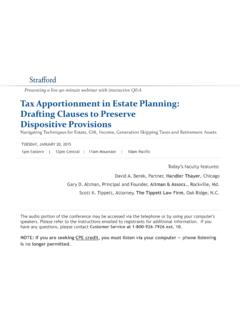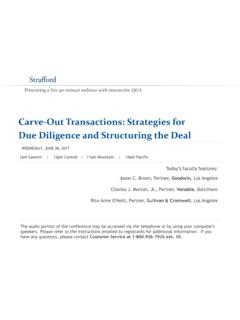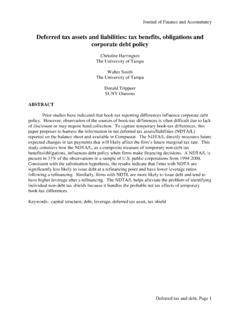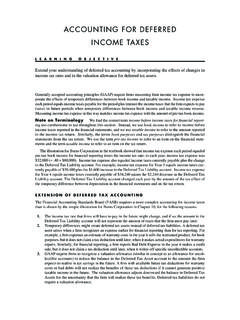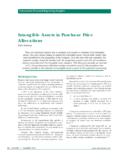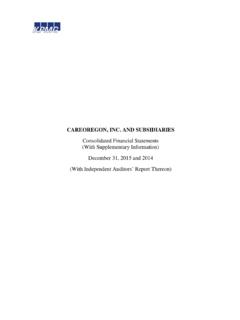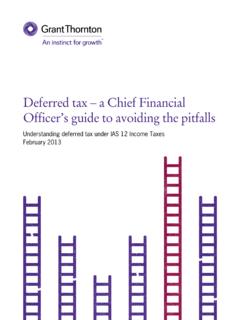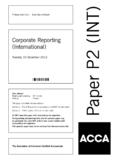Transcription of ASC 740 and Valuations of Deferred Tax Assets
1 Presenting a live 110 minute teleconference with interactive Q&AASC 740 and valuations of deferred tax assets Tackling To u gh valuation and Disclosure Challenges and Recovering Prior Allowances1pm Eastern | 12pm Central | 11am Mountain | 10am PacificTUESDAY, MAY 3, 2011 Today s faculty features:1pm Eastern | 12pm Central | 11am Mountain | 10am PacificCharles Chubb Managing Director WTAS PhiladelphiaCharles Chubb, Managing Director, WTAS, PhiladelphiaDavid Bussius, Managing Director, Tax Group, CBIZ Tofias, Providence, Siegel, Senior Tax Manager, BDO USA, AtlantaPatrick Tu l e y, Partner, Porter Keadle& Moore, AtlantaFor this program, attendees mustlisten to the audio over the Tu l e y, Partner, Porter Keadle& Moore, AtlantaPlease refer to the instructions emailed to the registrant for the dial-in can still view the presentation slides online.
2 If you have any questions, pleasecontactCustomer Service at1-800-926-7926 ext. MaterialsIf you have not printed the conference materials for this program, please complete the following steps: Click on the + sign next to Conference Materials in the middle of the left-hand column on your screen hand column on your screen. Click on the tab labeled Handouts that appears, and there you will see a PDF of the slides for today's program. Double click on the PDF and a separate page will open. Double click on the PDF and a separate page will open. Print the slides by clicking on the printer Education CreditsFOR LIVE EVENT ONLYA ttendees must listen to the audio over the telephone. Attendees can still view the presentation slides online but there is no online audio for this program.
3 Please refer to the instructions emailed to the registrant for additional information. If you have any questions, please contact Customer Service at 1-800-926-7926 ext. 18009267926 ext. for Optimal QualitySd QlitSound QualityFor this program, you must listen via the telephone by dialing 1-866-258-2056 and entering your PIN when prompted. There will be no sound over the web ect o .If you dialed in and have any difficulties during the call, press *0 for assistance. Yo u m a y a l s o send us a chator e-mail so we can address the QualityTo maximize your screen, press the F11 key on your keyboard. To exit full screen, press the F11 key againpress the F11 key d Vl ti f Df d T ASC 740 and valuations of deferred tax assets SeminarMay 3, 2011 David Bussius, CBIZ Chubb, WTAS Tuley, Porter Keadle & Moore Siegel, BDO USA d ay s ProgramIntroduction[Charles Chubb]Slide 7 Slide 10 Drill-Down On ASC 740/FAS 109 Rules[David Bussius and Charles Chubb]Slide 11 Slide 43 Tax-Related Challenges[Mark Siegel]Slide 44 Slide 62 valuation -Related Challenges[Patrick Tuley]Slide 63 Slide 73 INTRODUCTIONC harles Chubb, WTAS LLCINTRODUCTIONASC 740 (formerly FAS 109)
4 Balance sheet perspective Current payable/current receivableRthti dtfthtoReports what is owed to or from the government on a income tax return Deferred tax liabilities oReports what may be owed in the future Deferred tax Assets (today s focus) oReports what may reduce taxes in the future8 ASC 740: Basic principles (Cont.)Blh tti Balance sheet perspective FIN 48 liabilityoReports unrecognized tax benefits for uncertain taxoReports unrecognized tax benefits for uncertain tax positions9 ASC 740: Basic principles (Cont.) GAAP (generally accepted accounting principles): Provide the GAAP (generally accepted accounting principles): Provide the guidelines in evaluating the amounts reported in the financial statements Key point: FAS 109 is governed by accounting standards and Key point.
5 FAS 109 is governed by accounting standards, and many of the important principles in FAS 109 are similar to other elements of the financial statement Bi CBIZ TfiDRILLDOWN ON ASC 740/FAS David Bussius, CBIZ TofiasCharles Chubb, WTAS LLCDRILL DOWN ON ASC 740/FAS 109 RULESO verview valuation allowance defined Financial accounting principle that reduces a Deferred tax asset Financial accounting principle that reduces a Deferred tax asset to its net realizable valueThe conceptual framework is similar to evaluating other Assets The conceptual framework is similar to evaluating other Assets on the balance sheet. Accounts receivable Intangibles12 Overview (Cont.) A Deferred tax asset must be reduced by a valuation allowance ifbased on:based on.
6 The weight of all the evidence available it is more likely than not (a likelihood of > 50%) that some portion or all of thenot (a likelihood of > 50%) that some portion or all of the Deferred tax asset will not be realized13 Overview (Cont.) valuation allowances do not deal with the existence of the asset ; instead, they address the realizability of an asset . This is an important distinction from ASC 450 (formerly FAS 5) and ASC 740-10 (formerly FIN 48), which determine whether an asset is recognizable (meets the criteria to be benefitted) asset is recognizable (meets the criteria to be benefitted). For example: A net operating loss (NOL) created through an aggressive tax position on a tax return may not beaggressive tax position on a tax return may not be (Cont.)
7 All available evidence, both positive and negative, needs tobe to be considered. Assessing the need for and amount of a valuation allowance for DTAs requires significant judgmentDTAs requires significant judgment. Early coordination with the F/S auditors is important to avoid/reconcile inconsistencies between the company s and auditor s judgmentsauditor s Concepts Realizability: The question is: Willthe company have enough future taxable income to realize a cash benefit?a cash benefit? More likely than not (> 50%) standard Positive and negative evidence: Weight given based on objective verifiability Key concept: Must be based upon documentation that supports conclusion reached by company and also provide adequate financial statement audit support 16 Key Concepts (Cont.)
8 Key Concepts (Cont.)Evaluation Analysis is done on a separate, jurisdiction-by-jurisdiction basis Important concept in evaluating multi-national or multi-state groupsoWinners-and-losers issue Often missed in groups that are profitable overall but have some loss companieshave some loss companiesoOther positive or negative evidence may be different among the jurisdictions. Scheduling out the reversal of temporary differences may be Concepts (Cont.)Key Concepts (Cont.)Other considerations Evaluation of the valuation allowance Changes in judgment: P&L impact considerations Be mindful of events that could cause release of the valuation allowance Confusion with ASC 740-10; ASC 740-10 is applied first Confusion with ASC 74010; ASC 74010 is applied first If the DTA is determined not to exist under ASC 740-10, then no realizability evaluation is EvidencePositive EvidenceASC 740-10-30-18 identifies four sources of taxable income that are to be considered as positive evidence:1)Future reversal of existing taxable temporary differences2)Taxable income in prior carryback year(s)3)Future taxable income exclusive of reversing temporary3)Future taxable income, exclusive of reversing temporary differences and carryforwards4)Tlitti4)Tax planning strategies19 Positive Evidence (Cont.
9 Positive Evidence (Cont.)How many factors need to be considered? If one of the factors is sufficient to indicate that a valuation allowance is not necessary, then the other factors do not need to be evaluated. However if a valuation allowance is required then all the factors However, if a valuation allowance is required, then all the factors must be considered to determine the amount of the valuation allowance. Key point: Evaluating tax planning strategies is not Evidence (Cont.)Positive Evidence (Cont.)Which factors should be given the most weight? Typically, the factors given the most weight are the least subjective, resulting in the following order from strongest to weakest evidence:weakest evidence: Carrybacks Reversal of temporary differencespy Tax planning strategies Future taxable income exclusive of temporary differences21 Positive Evidence (Cont.)
10 Future reversal of existing taxable temporary difference Consideration must be given to the timing of the reversal of the temporary differences into taxable zero book income Assumes zero book income22 Positive Evidence (Cont.) Future reversal of existing taxable temporary difference (Cont.) Many timing differences based on current reserves (i e payroll Many timing differences based on current reserves ( payroll accruals) reverse in one year. Other DTAs are more reserves Warranty reserves Depreciation23 Positive Evidence (Cont.) Future reversal of existing taxable temporary difference (Cont.)-Future reversal of existing taxable temporary difference (Cont.) ExampleDTAsDTAsBad debt reserve - 10 NOL expires in 3 years - 380 DTLMACRS depreciation 5-year property - $4,000 Cost (1st year) - (400)(assume purchased mid-year and GAAP depreciation is straight-line) The net DTA/DTL is zero but scheduling is requiredThe net DTA/DTL is zero, but scheduling is Evidence (Cont.))






